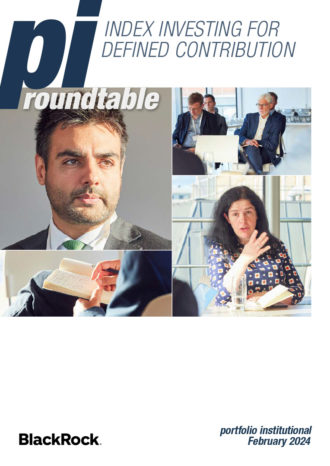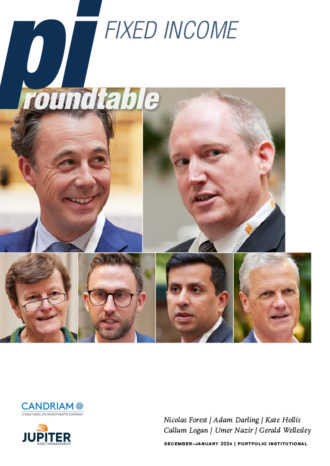
From left to right: Gerald Wellesley, Client director, Punter Southhall Governance Services / Anand Kwatra, Life and investment actuary, Phonenix Group / Julien Halfon, Head of pension solutions, BNP Paribas Asset Management / John Atkin, Director, Fixed income, M&G Investments / Oliver Hamilton, Principal consultant, Townsend Group, an Aon company / Peter Martin, Investment officer, Medical Defence Union
portfolio institutional: How popular is private debt among institutional investors?
Gerald Wellesley: It has become a default option for schemes that are not crazy about the yields they are getting from their fixed income portfolio.
Those that are well funded tend to stay away from private debt, not least because they might need the liquidity if they approach buy-out faster than they expect. They may also not need the yield. It has become extremely popular with under-funded schemes. Private loans can yield between 4% and 8% whereas investment-grade corporate bonds pay an awful lot less.
Anand Kwatra: Insurers are attracted to private debt for the illiquidity premium. Sometimes it is for the improved return on capital because these assets can attract a lower capital charge relative to a corporate bond.
The key thing is that it improves your cash-flow matching, while the pricing advantage is another driver. Insurers are using private debt to back individual and bulk purchase annuities. In the bulk annuity space, their allocations to private debt may typically range from 40% to 60% .

You not only want specialists to go out and find the right loans but specialists to go out and get the money back if there’s an issue.
– JULIEN HALFON, BNP PARIBAS ASSET MANAGEMENT
PI: What impact have insurers chasing similar assets had on yields?
Kwatra: In longer dated assets, like infrastructure, yields are compressing. But it is not necessarily about just measuring the illiquidity premium; it is also finding long duration assets.
PI: What conversations are asset managers having with institutional investors when it comes to private debt?
John Atkin: We do not view it as private or public debt; we just see it as financing. We look at the upsides and downsides of its various forms to find out which is appropriate for our individual clients. We try to find deals which give good value, which is a diminishing number given the weight of assets being deployed into this area.
The market has become fashionable, so infrastructure debt might not be attractive from a pension scheme perspective, whilst insurers are buying Solvency II assets.
Schemes need to find other ways of getting quality cash-flows. That might be funding the NHS or longlease property; it is all finance in some form.
Peter Martin: You are lending money. There are different labels to it, but it’s part of that holistic universe where you are seeking an income stream.
A lot of people prefer contractual income and if the return is sufficient for your needs, why wouldn’t you consider those areas?
In the past 10 to 20 years, lower yields from mainstream liquid assets have meant that investors need to work smarter to achieve those returns. It is not as though these things were never out there, it’s just that you did not need to look further afield. Now people need to consider these areas to generate a return to pay pensions and insurance claims.
PI: Is debt tied to physical assets such as property or infrastructure proving more popular than unsecured lending?
Oliver Hamilton: On balance no, but we are far more cautious on unsecured lending than we have been in the past. You need to look past where the money is flowing and instead look holistically at illiquid credit because relative value changes over time. In real estate debt, for example, our clients were investing in punchier, high-yielding strategies in 2012. We were comfortable with that as the banks had retreated rapidly from the market and the UK property market was expected to produce strong returns. Today, the UK real estate market is late cycle and you probably want to invest in more senior structures, rather than mezzanine.
The point is that your needs change over time, so don’t keep investing in the same asset classes.
As opportunities change, reassess the situation and if needed change your views. It is also important to be aware of how individual client needs are changing and to change your advice according, for example considering less risky illiquid strategies as a pension scheme de-risks.
Wellesley: When banks retreated in 2012 there was an opportunity to pick up good loans at a discount. The lending business has now, to a large degree, moved to institutional investors.
The vast bulk of these lenders who are backing private equity have not been through an industry cycle, so it is an untested market if the eventual downturn comes. In the low yield environment, there has not been an ability to build up what banks have traditionally had which is a group of rottweilers who are good at capturing value from a loan that is deteriorating.
If you have an industry populated almost entirely by people who are good at putting the assets on it’s difficult to have the appropriate safeguards in place. Assumptions about recovery rates will be optimistic. There has not been the experience to know what they will truly be and you do not have the people who are different from those bringing the loans in.

“You cannot pile all your assets into private debt because you could lose the opportunity to exploit these market dislocations.”
– Anand Kwatra, Phoenix Group
Martin: Fundamentally, if you are lending money it is the underwriting and sustainability of the entity that you are lending to that’s important. If you get the underwriting right, and the borrower can sustain its payments and pay you back then you should be insulated from those things.
Hamilton: When things go bad, and they can given that most strategies are sub-investment grade, you need a manager with the experience to manage it through the worst and try to maximise returns for investors. We are seeing new entrants in the direct lending space that do not necessarily have that experience.
Julien Halfon: The crucial first step is origination. Corporate bond yield rates have compressed so much that you are probably better off in senior unlisted illiquid assets, which when well originated can generate between 200 to 300 basis points above gilts. That will allow you to get a positive real yield, but you also need somebody behind it that will recover the cash if there is a default.
Martin: Loan managers are great at getting the deal, but if they are lending for five years they need to ask if that entity will exist in five years’ time. One example is the Yellow Pages, which went bad because it did not cope with the changes that the web brought.
Everyone has a great story about how they found a loan but spend less time telling you how they are monitoring it. It’s always about the new deal, but the less sexy aspects are more important, such as money laundering, refinancing or when you get the money back.

“Everyone has a great story about how they found a loan but spend less time telling you how they are monitoring it.”
– Peter Martin, Medical Defence Union
Atkin: It is important to recognise that there is no such thing as a good or bad asset; there is only a good or a bad price. Look at a deal in its entirety and ask if you are being sufficiently compensated for the complexity and illiquidity that you are taking on. Are you getting security over the assets? Can you negotiate the covenant package? Accidents happen so you need to ensure that you are protected by the spread.
PI: Is there a lot of competition for deals?
Atkin: Private debt has become fashionable. A colleague of mine was told recently that there were eight managers in Japan that week promoting European mid-market lending funds. That gives you an idea of the degree to which this space is becoming crowded.
Kwatra: When an insurer shapes a deal they are thinking, is the spread return wide enough for the asset to withstand a one notch downgrade.
Our capital models get a lot of scrutiny from the regulator about our workout ability and recovery rate assumptions to the extent that we have separate teams responsible for overseeing our asset managers to ensure that they can demonstrate that workout expertise. That is why in insurance land it can take one to two years to get approval to invest in a new asset and prove it’s similar to something you already own and that you understand the risks.
Martin: The noises I have heard about US and European loans is that, in some cases, there are addbacks, which is where companies massage the numbers to hide leverage. You need to make sure your manager is aware of these things and then take account of that in the pricing and spreads. If there are people who only buy into companies where the numbers have been massaged, then that chicken will come home to roost at some point.
You may be in a perfectly safe, well-underwritten loan, but there will be a mark-to-market pricing issue. It may affect liquidity in secondary markets. Although, these things are important, you have to think of the wider environment. If there is bad behaviour from the borrowers and it’s not taken account of, then you will catch a cold at some point. You do not want a repeat of 2009.
Halfon: One of the advantages of this is to avoid being segmented. If you only have access to one or two markets, you are probably going to end up with a diversification issue.
For example, let’s consider, hypothetically, that European mid-market loans are over-priced for the moment, but the US ones may at the same time be under-priced. There has not been much value in sterling infrastructure debt for three or five years, but Southern European infrastructure loans are quite good. You can get senior debt for 220 basis points above a government bond. If you can look at the same thing but more dynamically and not limit yourself to one or two areas you can optimise quality, risk and long-term reward.
The attraction for UK pension schemes, especially defined benefit ones, is that you get a supply, which, even though demand is high, remains quite significant. You can find different debt, of different quality, different segments and different types of risk. You have a lot more choice than if you were limited to listed UK corporate bonds. If you are completely stuck in the liquid world, you will not be as able to structure a coherent and successful investment strategy.
Wellesley: That diversity is critical because you are taking high risks. All managers say that they are selective, but somebody is doing those covenant-light deals and the ones with the hidden leverage. What I like to hear from managers is about the deals that they are not doing and why they have not done them. That gives me an insight into their underwriting discipline.
I hear managers often say that they stayed away from deals because they are in crowded markets and are not appropriately structured. That builds more confidence with me than discussing the deals they have done.
Halfon: During the private equity infrastructure craze before 2008, managers were coming to me with the same deal, which was a car park in Chicago. I saw that coming in time and time again.
Wellesley: The Battersea Power Station development came back several times, too.
Kwatra: Diversity is something which has hit the insurance sector in the past couple of years. There have been repeated warnings from the regulator about exposure to property risk via social housing, ground rents and equity release mortgages. There was an example last year where the regulator made an announcement on equity release mortgages. You could have suffered if you were not diversified. So being diversified at all levels of the investment process in private debt is important.
Martin: People were trying to sell European midmarket products a couple of years ago. They were talking about 10 to 15 loans, which fundamentally was wrong. If you get one wrong, you lose 5%, or at least a year’s worth of coupon. It is even more important in illiquids.
Hamilton: That is one of the challenges for pension schemes. We have large clients who are sophisticated and can invest across multiple funds in different asset classes and different regions, but we have smaller clients who want to access illiquid assets but cannot easily.
We need to be clear; most direct lending strategies are sub-investment grade loans, so putting 10% or 15% or more of your total scheme assets into an opportunity like that and maybe with one manager does not make sense. There are some multi-asset illiquid funds out there, some of them are good but they are few and far between.
Our philosophy is if you are accessing different illiquid credit strategies – and you have the funds and governance to do so – you should select the best manager to run each mandate. However, finding someone to do it all well, and in the right structure, is extremely difficult.

“You need to look past where the money is flowing and instead look holistically at illiquid credit because relative value changes over time.”
– Oliver Hamilton, Townsend Group, an Aon company
Halfon: You not only want specialists to go out and find the right loans but specialists to go out and get the money back if there’s an issue. That default management layer is crucial.
The other added value that these strategies provide is in how you reinvest the money. A lot of those loans are amortising quite fast but with some degree of uncertainty. You can have an eight-year maturity for a loan to a small-to-medium sized company but most of the capital may be amortised after four years. Aside from the coupon and the capital, you get cash coming from contributions and perhaps, for defined benefit schemes, from changes in asset allocation.
If you do not have that cash management specialisation, the cash-flow driven investment (CDI) strategy will not work as well as it should. It took us a bit of time to assess that originators working separately on the portfolio management aspects is not optimal because they each have a tendency to reinvest the money into their own area of expertise, so, for example, all the infrastructure money will go back to infrastructure. Then you get into the trap of illiquid asset classes not being valued relative to each other and you don’t have a cohesive asset allocation anymore.
Martin: It takes months to get deals signed, so if a liquid equivalent becomes much cheaper and the spread widens, you need to be able to think slightly wider. If you can get 300 basis points from an asset that is liquid, why would you lock yourself into something that’s illiquid?
In the more volatile markets that we are probably entering, there will be pockets of opportunity in the liquid space which we should not ignore. What you tend to find is that private debt managers do not think like that because they are committed to the deal. As the asset owner, you have to be smarter and partner with someone who will look at illiquid opportunities as and when they arise.
Kwatra: That is what I would label a “risk”. We have talked about downgrade risk and monitoring, but the opportunity cost is another risk. You cannot pile all your assets into private debt because you could lose the opportunity to exploit these market dislocations.
Atkin: The way we manage our portfolios and encourage our clients to align themselves with us usually starts with a liquid public market proxy. We only commit money to the private side once we know all the terms and are convinced that there is a pick-up in seniority security or spread.
Halfon: We try to get the best deals in illiquid, if we cannot we replicate using liquid assets. We monitor the illiquidity premium before deciding to invest or not. If we do not get the proper premium, which is rewarding you for the illiquidity risk of your loans, which may take a significant loss if you decide to sell before redemption, you should not be in that market. At the same time, thanks to our cash-flow management layer, we constantly monitor the illiquidity premium.
Martin: You talk about cash-flow management, but there is spurious accuracy in any projection by an actuary. You should also not lock too much capital into illiquid assets because things like transfer values happen. There is a balance to be struck.
Atkin: If you look at the markets, it tends to be that the shorter end of the curve, sub-15 years, is where you get most of the public debt being issued. Once you drop off into the longer parts of the public debt markets you are stuck with some quite idiosyncratic risks. The ability to blend the public and the private together gives you a more reliable curve, but we certainly would keep a significant portion in liquid public markets as well.
Kwatra: A lot of what we have said about opportunity, cost and ensuring an illiquidity premium is almost advocating that you should not rush into private debt. A slow steady build-up is optimal.

PI: How does ESG fit into private debt?
Martin: The environment in which we are investing is changing in terms of what’s acceptable. The mining companies you may have lent money to three or four years ago now have carbon footprints to consider. You have to understand the changing environment, such as climate change risk, and what you will have to go through in terms of stress testing.
Wellesley: When the lenders were lending to Yellow Pages it seemed like one of the safest loans one could make, but the environment changed.
If you look retrospectively at climate aware funds or ESG funds, they have not performed particularly well and have been expensive to run. That doesn’t mean going forward we are not going to change rapidly. If public sentiment is changing at the pace that it is, a lot of these things that are back-tested are going to have no relevance in the forward-looking market in terms of whether certain business strategies become obsolete faster than expected. A whole new level of awareness is required.
Martin: You cannot anticipate everything, so having the mindset to at least think wider is important.
Kwatra: It’s going back to what assets are going to work in 10 or 20 years’ time.
Atkin: The longer your investment horizon, the less reliable your credit rating process can be, so you rely more on the security of real assets or some form of governmental guarantee to provide you with comfort.
Martin: Five or 10 years ago, when supermarkets and hypermarkets such as Tesco and Sainsbury’s were in favour, property income products where quasi-supermarket funds. Shopping habits have changed and those hypermarkets are not as in favour now.
In 2013 and 2014 a lot of money was lent to people buying shopping centres in the UK. I imagine those people are having an interesting time at this point given the property cycle.
Hamilton: It goes back to the underwriting and the analysis of the underlying collateral and having a “Plan B” if the borrower’s plan fails. For example, if you have lent against a commercial property, knowing there is a strong alternative use value – for example, residential – is important and we have seen this recently with loans secured against retail assets.
PI: What impact have new players entering this market had on covenants?
Atkin: There has undoubtedly been an erosion of covenants and spreads have compressed. You have to look at the market and ask how a private asset with higher leverage and a covenant that has been eroded stacks up against debt assets in the public markets.
Always look at the relative and absolute value when looking at these deals. Accept that life changes and try to stay at the leading edge of what is available. New and unfashionable sectors are often best because the moment things become fashionable they become more heavily bid, so poorer value.
Halfon: Although there may be a lot of competition, to do something as complex as private debt well, you need a bit of history, you need resources and expertise that are not readily available to everyone. We are a big bank but it took us 30 years to build a track record in the US.
On paper, there seems to be a lot of supply, but you need to look hard for good quality.
Hamilton: In real estate debt we have not seen weaker covenants in terms of loan-to-value and interest cover ratio protections. One of the things that has changed, which is a worry, is call protection. Typically for higher yielding strategies, a borrower has a plan to improve a building and sell it for a profit and would take out a three to five-year loan. If that property is sold early, say within 18 months, a lender needs to be protected somehow from the loss of coupon, typically by the loan guaranteeing some minimum return. But these are disappearing. That’s a worry. As an investor you want to keep your money working.
The other thing we are seeing more of is that in a few cases borrowers are re-financing the debt and taking a material amount of equity out of the asset – essentially crystallising a profit. That changes the dynamic of how they are going to act if the asset subsequently gets into trouble. Debt managers are aware of this, but some are underestimating how the borrower will act differently to the situation where they have not de-risked.
That is what we have seen with real estate loans. The concern is if the borrower had not taken equity out of the structure, they would work harder and adapt the business plan to get problems sorted rather than hand back the keys.
The other aspect I am wary about, is not so much covenants being weakened, but a manager growing its product range and fund sizes leading them to make loans against assets which they would not have done a couple of years ago.
Martin: The term “cov-lite” has been talked about for many years in the US loan market. I try to differentiate between the US and the European loan markets, they have different dynamics. I prefer European loans because they do not have the same market dynamics and pricing issues that you face in the US.
Cov-lite is a change in the European market but is not a reason not to do it. I sometimes wonder if managers proving loans are relying too much on having many covenant provisions.
Hamilton: Covenants when structured properly do work. In real estate, covenants protect managers by letting them take control of assets early to manage an issue. Where they have been in junior positions, they are protected from the actions of the senior lender by having some breathing space to sort the problem out. For example, if an inter-creditor agreement between senior and mezzanine debt is pretty weak, a forced sale of the asset by the senior could happen at the worst time resulting in large losses for the mezzanine provider.
Martin: You have to make a judgement on the spread you are getting, the underwriting, how you deal with the management company and how trustworthy they are.
Just because things have become cov-lite and you may not have all the bells and whistles you previously had does not necessarily mean that you should avoid that area completely. That is too dogmatic. You have to underwrite appropriately.
If you have management information or the financials, in practice how does that help? Could you have solved a particular problem? Does it tell you anything? What practical difference does information make?

“A set of covenants does not make a bad loan good. You want a good loan to start with.”
– Gerald Wellesley, Punter Southall Governance Services
Wellesley: A set of covenants does not make a bad loan good. You want a good loan to start with. It is more the case in the property area that getting control earlier rather than later is an absolute advantage. It is a question of discipline and I am not sure what is providing that when there’s a wall of money going into this space.
In the past, where this has been mostly on banks’ balance sheets, it was a manager’s budget that they have to make and if the margin is half what they were making before they have to make twice as many loans. So there has been a lack of discipline there.
At the moment, I’m not sure where the discipline lies. You hope it lies within the realms of the manager and if they have a diversified approach maybe they can be more selective, but I am not sure your average pension trustee has the discipline to say: “I’m not comfortable here, it looks like we are not getting adequately compensated for the risk that we are taking.”

“It is important to recognise that there is no such thing as a good or bad asset; there is only a good or a bad price”
– John Atkin, M&G Investments
Atkin: The traps out there are significant and manager selection in private assets is several magnitudes more important than it is in public markets. Firstly, the ratings that are used are set by the managers themselves, they can rate those assets however they wish. Similarly, the managers are building the covenant package with the borrower, they are looking at the security package, they are negotiating the terms; there’s a huge amount of trust you are giving them.
One of the things we are often cautious of is single sector funds. Fashion can move quickly, so you could end up telling your clients to stop investing that area, if they are not being rewarded as they had hoped.
Martin: If there is not enough juice left, stop investing. That also applies to multi-strategy and multisector funds.
If you cannot invest sensibly without going down the rating, going from senior to junior or needing some financial leverage to up the return you need to trust your manager to say: “I was going to deploy the money at this spread, I can’t invest it, what do you want me to do?”
Make sure there is a mechanism in place so they are not just gathering assets and you suddenly find that where you thought you were getting Libor+ 300 you get Libor+ 150 and you are stuck.
Atkin: The incentives come terribly into focus here. If you have a manager who is being incentivised to spend money no matter what, and into the highest return possible when they are in control of the risk, then you have created a potential problem. Whereas, if you have a strategy which includes public and private markets with a longer-term return target then the manager is not incentivised to spend money poorly.
Martin: There was an infrastructure debt product that I saw the details of last year that was charging just an asset under management monitoring fee and a fee for the deal. In that arrangement they are incentivised to do the deal and to deploy the money relatively quickly. Those arrangements are something to be wary of.
Wellesley: There are funds that are being sought by managers who have not even spent the previous funds. They are already gathering funds for the next one, so what incentives does that stimulate?
Hamilton: The funds that they are raising the next time around tend to be bigger than the previous ones. So if returns are lower, performance fees are falling, the fee managers’ receive for investing capital in a €5bn (£4.4bn) fund compared to a €1bn (£884.7bn) fund more than compensates them for the reduction in the performance fee.
Wellesley: If a manager underwrites poorly and makes bad loans their reputation can suffer but the asset management company will still pocket their fees and are not carrying any risk on their balance sheet, whereas, of course, the investors are. The banks that used to lend, where the people making the decisions were not carrying the risk created false incentives.
Hamilton: We worry about smaller boutique managers being bought out by bigger firms, despite there being clear operational benefits. Typically, managers sell a small proportion of the business on day one with an option to buy-out fully in the near future. They are incentivised to grow revenues by launching new products because the pay day when they are bought out full is going to be much if short-term revenues have grown. Once they get that pay day, how are they then locked in and incentivised to stay?
PI: I have read that securitised vehicles are on the rise again. Is that true?
Wellesley: They are becoming more popular. There is renewed interest because yields are picking up in some of those markets. Whether you are backed by car loans or mortgages, there are good managers out there and some reasonable opportunities.
Hamilton: Again, especially at the senior end of the spectrum and probably investment grade, some of the returns you can get from structured credit are attractive and similar to what you can get in the illiquid space – with a lot more liquidity. If you are a pension scheme that does not have some of the issues investing in structured credit like insurers or banks do, then it should be considered too.
Martin: In the past few years the use of collateralised loan obligations (CLOs) in credit products has been growing.
A few years ago, AAA or AA was sufficiently attractive to get you what you want but now the BB space seems to be the sweet spot for a number of managers.
There’s nothing wrong with that, it’s just that you need to understand the product you are investing in. I have always been cynical about conflicts in equity CLOs when managers have manufactured them.
Kwatra: We see a lot of these in the insurance space and we often say no because of regulation. When you mention the word ‘securitised’ to an insurer they would probably say that they are comfortable with social housing loans with the underlying security or an equity release mortgage, that’s what we see as securitised. So it can be interpreted in different ways.








